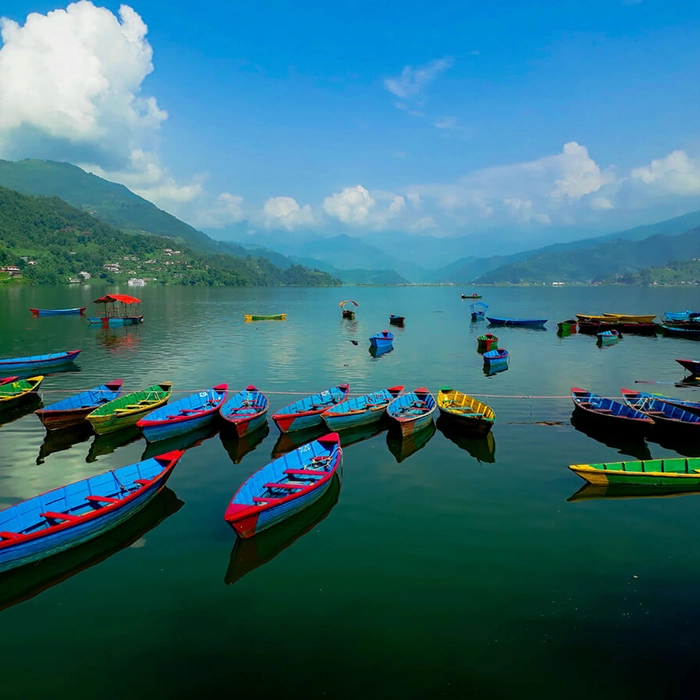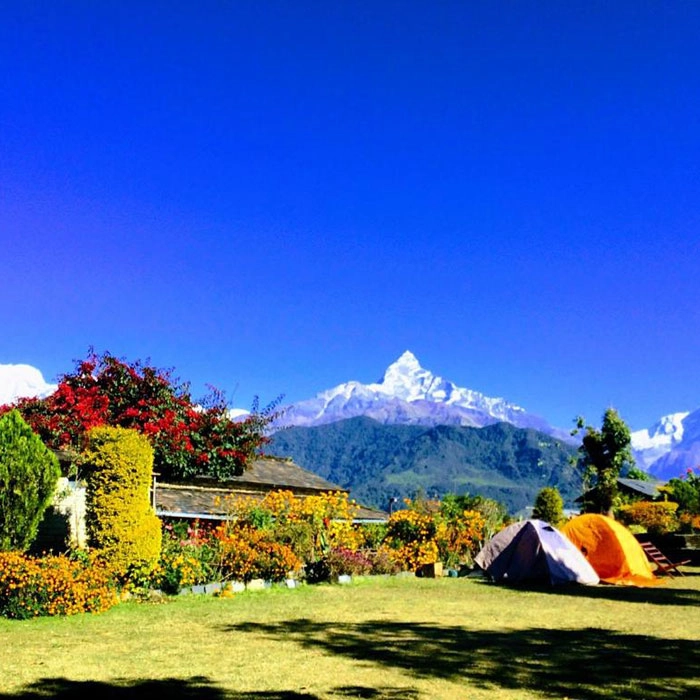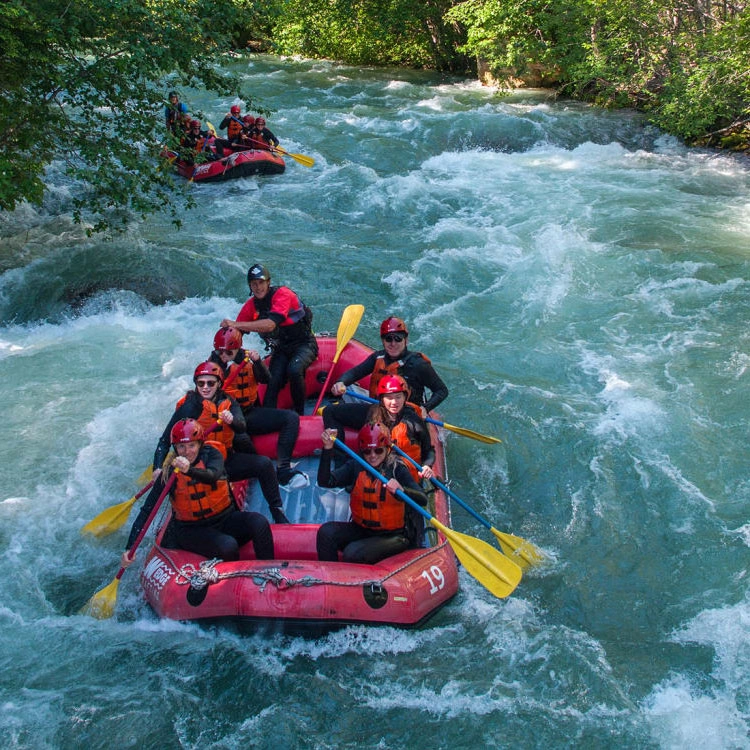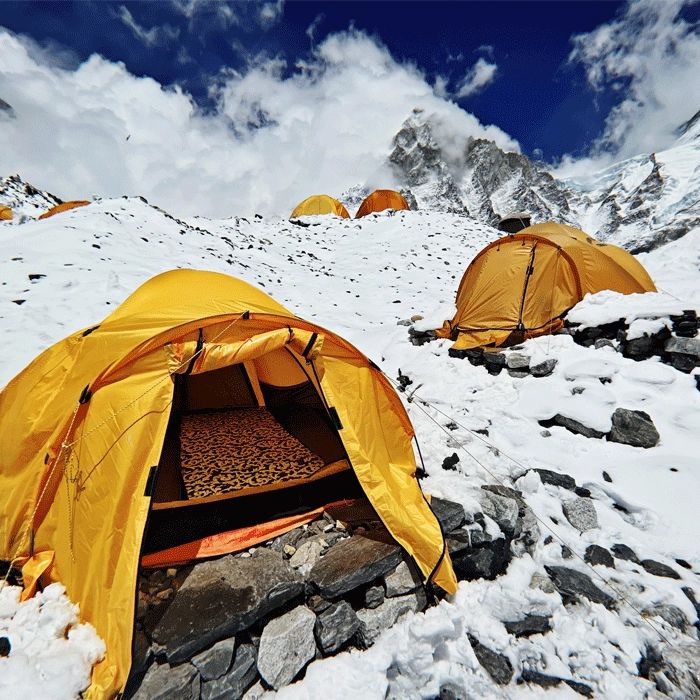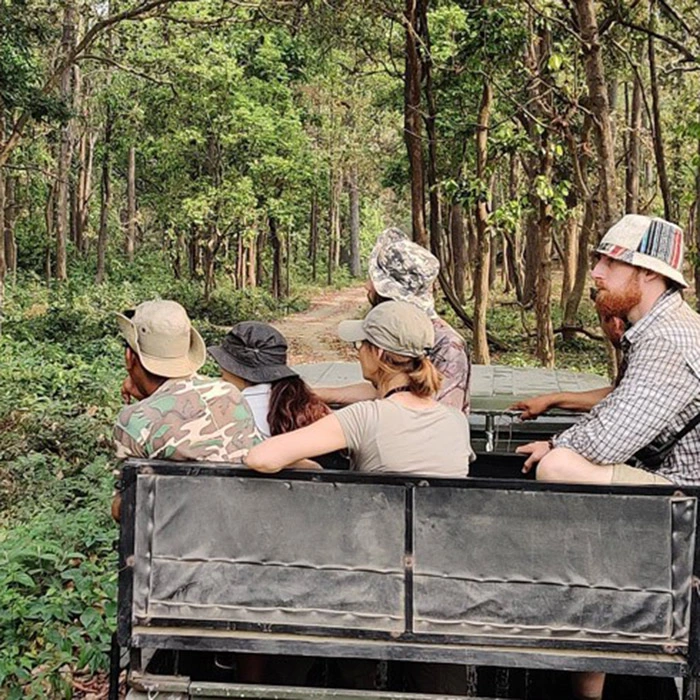GOSAIKUNDA LAKE TREK
US$1,710.00
/pp
-
14 Days
-
Langtang
-
Spring/Autumn
-
Trekking
-
4,610 Meters
-
Moderate
-
Jeep / Bus
-
01-16 People
-
JH#243
 Overviews
Overviews
Experience the Gosaikunda Lake Trek, a journey that perfectly combines stunning landscapes, sacred lakes, & rich cultural immersion in Nepal. Starting from Sundarijal, the gateway to the Helambu Circuit Trek, this adventure ascends through enchanting rhododendron forests towards the sacred Gosaikunda Lakes. Along the way, traverse charming villages adorned with ancient monasteries and chortens, offering an insightful glimpse into the region’s vibrant local culture and spiritual traditions. This trek provides breathtaking views of Langtang Lirung (7,227 m) and other majestic Himalayan peaks. At approximately 4,380 meters, the Gosaikunda Lakes come into view, nestled in a dramatic alpine setting. These lakes hold profound spiritual significance for both Hindus and Buddhists, drawing thousands of pilgrims each year. The Gosaikunda Lake Trek delivers an exceptional combination of breathtaking landscapes and rich cultural experiences, ensuring a profoundly memorable and immersive journey through Nepal’s majestic highlands and spiritual realms. Compared to the Annapurna Base Camp Trek and Everest Base Camp Trek, known for their diverse landscapes and challenging routes, the Gosaikunda Lake Trek offers a serene retreat into Nepal’s spiritual heartland. While the Annapurna Base Camp Trek features a variety of scenery from lush forests to high-altitude deserts, and the Everest Base Camp Trek is famous for its rigorous trails and iconic views of the world’s highest peak, Gosaikunda offers a more tranquil experience. This trek fosters a closer connection with nature due to its peaceful environment and fewer crowds. The higher elevations reveal awe-inspiring vistas of snow-capped peaks and glacial valleys. Trekkers will enjoy the serene beauty of the trail and the pristine waters of Gosaikunda Lakes, which reflect the surrounding mountains with breathtaking clarity. Combining natural grandeur with cultural depth, the Gosaikunda Lake Trek is an ideal choice for those seeking a tranquil yet rewarding adventure in Nepal. Gosaikunda Lake Trek DifficultyThe Gosaikunda Lake Trek is a moderately challenging 7–10 day Himalayan adventure, suitable for trekkers with good physical fitness and proper acclimatization. Covering approximately 40–50 km, the trail passes through dense rhododendron and pine forests, rocky paths, alpine meadows, and glacial streams, highlighting both natural beauty and cultural heritage of the Langtang region.
Trekkers typically walk 4–6 hours per day, depending on the stage of the trek and altitude. The journey reaches its highest point at Gosaikunda Lake (4,380 m / 14,370 ft.), where careful acclimatization and a steady pace are essential to avoid altitude-related issues.
Although shorter and less strenuous than Everest Base Camp or the Annapurna Circuit, the Gosaikunda Lake Trek provides equally rewarding experiences, including breathtaking Himalayan landscapes, panoramic snow-capped views, and authentic encounters with Tamang and Sherpa culture. Gosaikunda Lake Trek CostTrekking to Gosaikunda Lake requires a Langtang National Park permit and a TIMS card, totaling around USD 50–70. Beyond permits, the overall trek cost depends on transportation, accommodation, meals, guides, and porter services. Expenses vary based on comfort level, service packages, and mode of travel to the starting point at Sundarijal or Dhunche and back to Kathmandu.
Many trekkers choose a private 4WD jeep from Kathmandu to Dhunche or Sundarijal, costing around USD 150–180, which is faster and more comfortable than local buses for remote trekking areas.
Accommodation along the Gosaikunda Lake Trek is available in tea houses and lodges, ranging from basic to moderate comfort, with occasional upgraded rooms. Room costs typically range from USD 10–25 per night, increasing slightly in higher-altitude villages.
Food and drinks vary depending on the lodge and location. Meals generally cost USD 3–10 per item, bottled water around USD 4 per liter, and hot beverages like tea and coffee USD 2–3 per cup. Menu options are more limited at higher-altitude settlements, but fresh local dishes are widely available.
 Itinerary (Plan)
Itinerary (Plan)
Arrive in Kathmandu (1,400 m / 4,593 feet), Nepal's vibrant capital, where you'll be warmly welcomed with marigold garlands. After transferring to your hotel, take time to relax and acclimate to the bustling city. Discover vibrant local markets, indulge in traditional Nepali dishes, and delve into Kathmandu's rich cultural tapestry. This initial day is perfect for easing into your journey, setting the stage for the exciting adventures ahead in Eastern Nepal. A representative from Jagadamba Holidays will ensure a smooth and pleasant arrival.
Optional Evening Activity:
If you wish, you can spend your evening experiencing the Pashupatinath Aarti, a captivating religious ceremony held at the Pashupatinath Temple. The Aarti usually begins around 6:00 PM and lasts for approximately an hour. This ceremony is a mesmerizing display of traditional music and rituals, providing a profound insight into Hindu spiritual practices. Please check the exact time for the Aarti on the day of your visit, as it may vary. This option is not included in the standard itinerary but offers a unique opportunity to immerse yourself in local culture.
After breakfast in Thamel, Kathmandu, begin your adventure with a scenic drive to Sundarijal (1,460 m / 4,790 ft.), located just 14 kilometers northeast of the capital. The one-hour drive passes through bustling city streets, small settlements, and the green outskirts of the Kathmandu Valley. Known as the Gateway to Shivapuri National Park, Sundarijal is famous for its refreshing waterfalls, lush forests, and tranquil surroundings, making it an ideal starting point for your trekking journey in Nepal.
From Sundarijal, the trek to Chisapani officially begins with a steady ascent into Shivapuri National Park. The trail climbs gradually along stone steps, winding through dense forests of rhododendron, oak, and pine. The sound of cascading waterfalls and flowing streams accompanies your walk, while terraced farmlands and scattered Tamang villages provide authentic glimpses into traditional Nepali rural life. For nature enthusiasts and birdwatchers, this section is particularly rewarding, as the park is home to diverse Himalayan birds and wildlife.
As you gain elevation, the air becomes crisp and refreshing, creating a rejuvenating trekking experience. The Sundarijal to Chisapani trek covers approximately 9.75 kilometers and takes 5 to 6 hours to complete. Along the route, you will gain about 1,040 meters in elevation and descend 260 meters before reaching Chisapani. Short breaks along the way allow time to rest, enjoy the greenery, and capture photos of the scenic landscapes.
On approaching Chisapani (2,165 m / 7,103 ft.), the forested trail opens up to breathtaking Himalayan panoramas. On clear days, trekkers are rewarded with sweeping views of Langtang Himal, Ganesh Himal, and Dorje Lakpa. The peaceful hilltop village of Chisapani is dotted with traditional teahouses, offering warm hospitality and spectacular sunset and sunrise views over the mountains. It is the perfect place to rest after your first day’s trek and prepare for the adventures ahead in the Helambu and Langtang region.
After a nourishing breakfast at your lodge in Chisapani (2,165 m / 7,103 ft.), embark on the second day of your Helambu trekking adventure toward Kutumsang (2,470 m / 8,104 ft.). The morning begins with crisp mountain air, tranquil surroundings, and stunning views of the lush hillsides. Leaving Chisapani, the trail first descends gently, weaving through terraced farmlands, traditional Tamang homes, and vibrant greenery. This peaceful start offers a perfect introduction to the day, blending serene forest paths, local cultural encounters, and sweeping Himalayan panoramas.
The trek from Chisapani to Kutumsang spans approximately 16.7 kilometers and takes 7 to 8 hours to complete, with a total ascent of around 1,220 meters and a descent of roughly 920 meters. The trail gradually transitions from dense rhododendron, oak, and pine forests to open ridges that reveal spectacular views of snow-capped Himalayan peaks, including Langtang Himal, Ganesh Himal, and Dorje Lakpa. Along the way, trekkers encounter charming Tamang villages, gurgling streams, and diverse Himalayan wildlife, making this section both visually rewarding and physically invigorating. The combination of cultural exposure, forested trails, and panoramic mountain vistas makes this trek a highlight of the Helambu region.
The journey begins with a gentle descent toward Pati Bhanjyang, a scenic hill village known for its terraced farmlands and rural charm. From here, the trail gradually climbs toward Gul Bhanjyang, a quaint settlement where traditional Tamang culture is evident in daily life, hillside farming, and rustic homes. This section is filled with thick rhododendron, oak, and pine forests, accompanied by the soothing sounds of mountain streams, creating an immersive trekking experience for nature lovers.
As you continue, the path opens up along scenic ridges offering sweeping views of rolling valleys and distant snow-capped peaks. Clear days reward trekkers with breathtaking Himalayan panoramas of Langtang Himal, Ganesh Himal, and Dorje Lakpa, making it a perfect spot for photography and reflection. The trail alternates between shaded forest paths and open ridge sections, providing variety and maintaining a comfortable trekking rhythm. Wildlife enthusiasts may spot langur monkeys and colorful Himalayan birds along the route.
As Kutumsang approaches, the trail becomes steeper and more rugged, adding a sense of adventure before reaching the village. Kutumsang is a traditional Tamang settlement celebrated for its warm hospitality and stunning mountain backdrop. Here, trekkers can rest in local teahouses such as Hotel Namaste & Lodge, enjoy hearty Nepali meals, and prepare for the next day’s journey deeper into the Helambu region. The combination of forest trails, cultural immersion, and Himalayan vistas makes this trekking leg an unforgettable highlight of your Nepal adventure.
After a hearty breakfast at your lodge in Kutumsang (2,470 m / 8,104 ft.), embark on an invigorating trek toward Mangengoth (3,285 m / 10,778 ft.), a serene alpine settlement nestled in the tranquil highlands of Helambu. This picturesque village serves as a gateway to the higher Himalayan ridges, offering trekkers breathtaking views of remote landscapes, traditional Tamang culture, and pristine natural surroundings. As you ascend, the trail winds through peaceful forests, open ridges, and scattered farmland, providing a harmonious blend of cultural immersion and scenic variety along your journey deeper into the Helambu region.
The trekking route for the day spans approximately 6 kilometers and typically takes 3 to 4 hours to complete. Over this section, trekkers will gain roughly 860 meters in elevation while descending a gentle 40 meters, making it a moderately challenging yet highly rewarding stage of the Helambu trek. The trail alternates between stone steps, dirt paths, and shaded forested stretches, offering both invigorating exercise and ample opportunities for photography. Along the way, the crisp mountain air, sweeping Himalayan panoramas, and occasional sightings of Himalayan birds and wildlife make each step a memorable part of the trekking experience.
The journey from Kutumsang to Mangengoth begins with a steady ascent through tranquil forests of rhododendron, oak, and pine. The shaded forest paths, accompanied by the soothing sounds of mountain streams, create a serene trekking atmosphere, while glimpses of local wildlife, including colorful Himalayan birds and small mammals, enrich the experience. As you climb higher, the trail becomes more remote, offering a peaceful escape into nature and the crisp mountain air.
Gradually, the dense forests give way to open alpine terrain, where sparse vegetation and rocky ridges dominate the landscape. This transition reveals awe-inspiring panoramic views of the surrounding Himalayan peaks, including Langtang Himal and Ganesh Himal. The trail alternates between stone steps and dirt paths, growing steeper as you approach Mangengoth. Each section combines physical challenge with breathtaking scenery, rewarding trekkers with spectacular mountain vistas at every turn.
Mangengoth itself is a small yet charming settlement, frequently used as a resting point for trekkers exploring the higher reaches of Helambu. At this higher altitude, cooler temperatures and thinner air are noticeable, adding a sense of adventure to the journey. The village offers rustic teahouses where travelers can enjoy warm meals and relax while soaking in sweeping views of snow-capped peaks. This segment of the trek beautifully combines alpine landscapes, serene forest trails, and cultural immersion, making it one of the most memorable and rewarding legs of the Helambu trekking experience.
After enjoying a hearty breakfast at your lodge in Mangengoth (3,285 m / 10,778 ft.), set out on an invigorating trek toward Thadepati (3,690 m / 12,140 ft.), a serene high-altitude settlement renowned for its sweeping panoramic views of the surrounding Himalayan ranges. As you leave Mangengoth, the trail gradually ascends through a harmonious combination of dense forests, open alpine meadows, and scattered rocky paths, offering trekkers a captivating blend of natural beauty and cultural immersion. Along the way, you may encounter traditional Tamang settlements, yak pastures, and local herders tending to their livestock, providing an authentic glimpse into the daily life and customs of highland communities. The crisp mountain air, accompanied by gentle alpine breezes, enhances the refreshing trekking experience, making every step a memorable connection with the serene environment.
This trekking segment covers approximately 5.1 kilometers and typically takes around 3 to 4 hours to complete, making it a moderately challenging yet immensely rewarding leg of the Helambu route. Over the course of the day, trekkers will ascend approximately 440 meters and descend about 80 meters. The trail is well-marked but varies in terrain, featuring rocky patches, stone steps, and uneven paths that demand careful attention. As the elevation increases, the lush forest gradually gives way to expansive high-altitude meadows, revealing unobstructed vistas of snow-capped peaks, including the majestic Langtang Himal and Ganesh Himal. These scenic viewpoints, interspersed with shaded forest stretches, offer ideal spots to pause, capture photographs, and soak in the tranquil alpine atmosphere.
The journey from Mangengoth to Thadepati meanders through dense forests and open meadows, creating a perfect balance of shaded trails and panoramic clearings. Trekkers are treated to awe-inspiring views of the Langtang range and neighboring Himalayan peaks at several points along the route. Intermittent yak pastures and encounters with local herders enrich the trekking experience with a cultural dimension, offering a glimpse into the resilient lifestyle of high-altitude communities.
As you approach Thadepati, the trail becomes steeper and more rugged, with rocky sections and stone steps that require careful footing. This picturesque village sits at an ideal vantage point, allowing trekkers to admire the surrounding snow-capped peaks, rolling valleys, and distant ridges. The crisp mountain air and serene environment make Thadepati a perfect spot to rest, capture memorable photographs, and prepare for the next stage of your Helambu adventure.
The trek from Mangengoth to Thadepati seamlessly combines alpine landscapes, panoramic Himalayan vistas, and authentic cultural experiences. Despite the moderate physical challenge presented by steep climbs and uneven terrain, the breathtaking scenery, tranquil atmosphere, and highland charm make this leg of the Helambu trek an unforgettable highlight of your journey.
After a hearty breakfast at your lodge in Tharepati (3,690 m / 12,140 ft.), begin your trek toward Phedi (3,730 m / 12,200 ft.), a high-altitude settlement offering panoramic views of the surrounding Himalayan ranges. The trail gradually winds along a breathtaking ridge, showcasing the region’s majestic mountains, deep valleys, and vibrant alpine meadows. As you walk, clusters of rhododendron, pine, and oak trees line the path, creating a colorful and serene trekking experience, especially during spring when the blooms are at their peak. The crisp mountain air and wide-open vistas make this section of the trek both invigorating and visually spectacular.
The trek from Tharepati to Phedi spans approximately 8 kilometers and typically takes 4 to 5 hours to complete. Trekkers will ascend roughly 590 meters and descend about 480 meters, making this a moderately challenging day that balances effort with the reward of stunning Himalayan scenery. The trail alternates between rocky paths, dirt tracks, and stone steps, offering a mix of terrain that keeps the trek engaging while providing numerous opportunities for photography.
As you progress, the trail passes through remote highland terrain, with fewer settlements and basic tea houses along the way. This solitude allows trekkers to fully immerse themselves in the tranquility of the mountains. The ridge offers sweeping views of the surrounding valleys, distant snow-capped peaks, and seasonal alpine flora, making each step a memorable connection with nature. The final approach to Phedi involves a gentle descent into the village, where you can rest in a local teahouse, enjoy traditional Nepali meals, and prepare for the next stage of your Helambu adventure.
This segment perfectly combines alpine landscapes, panoramic mountain vistas, and peaceful forest trails, making the Tharepati to Phedi trek a truly rewarding and unforgettable leg of the Helambu trekking experience.
After a hearty breakfast at your lodge in Phedi, begin the exhilarating trek toward Gosainkunda, crossing the iconic Laurebina La Pass (4,610 m / 15,125 ft.). This section of the Helambu-Langtang trekking route is one of the most challenging yet rewarding parts of the journey. As you leave Phedi, the trail gradually ascends through rocky paths and high-altitude terrain, offering trekkers the first glimpses of sweeping Himalayan landscapes.
The trek spans approximately 6.5 kilometers (4 miles) and generally requires 4 to 5 hours to complete, depending on individual pace and rest intervals. Trekkers ascend roughly 910 meters (2,985 ft.) and descend about 240 meters (787 ft.), making it a strenuous yet highly rewarding journey. The trail includes steep rocky sections, uneven paths, and narrow mountain ridges, requiring careful navigation while offering unparalleled views of Langtang Himal, Ganesh Himal, and distant Annapurna peaks. Every turn brings a new perspective—from expansive snow-capped mountains to secluded valleys—ensuring each moment is memorable for photography and nature appreciation.
The highlight of today’s trek is crossing Laurebina La, the highest point along this route. The path is steep and rugged, with rocky sections and high-altitude conditions that offer a moderately to highly challenging trek. As you ascend, breathtaking panoramic views of the Langtang Himal, Ganesh Himal, and Annapurna range unfold before you. Fresh mountain air, sweeping ridges, and the peaceful beauty of alpine wilderness surround you throughout the trek, making the journey both physically invigorating and deeply inspiring.
After conquering Laurebina La, the trail descends toward the sacred Gosainkunda Lakes (4,380 m / 14,370 ft.), passing a series of pristine glacial lakes along the way. The largest, Gosainkunda, is a revered pilgrimage site for Hindus and Buddhists, celebrated for its shimmering blue waters and tranquil surroundings. The descent follows uneven, rocky paths, requiring careful footing but offering a striking contrast between rugged mountain ridges and serene, reflective lakes. This combination of physical challenge, awe-inspiring Himalayan scenery, and cultural significance makes crossing Laurebina La and reaching Gosainkunda an unforgettable highlight of the Helambu-Langtang trek, perfectly blending alpine adventure, spiritual beauty, and high-altitude wilderness.
After enjoying a hearty breakfast at your lodge, spend time exploring the serene and sacred Gosainkunda Lake, one of Nepal’s most revered alpine lakes. Believed to have been created by Lord Shiva, the lake holds immense spiritual significance for both Hindus and Buddhists. Its crystal-clear, shimmering waters reflect the surrounding rugged Himalayan peaks, creating a mystical and otherworldly ambiance. During winter and early spring, the lake is often blanketed in snow, adding to its tranquil and enchanting atmosphere. Pilgrims from across Nepal and India visit Gosainkunda during major festivals, performing rituals and bathing in its icy waters as an act of devotion. Beyond its spiritual importance, the lake is a natural wonder—home to unique alpine flora, migratory birds, and pristine high-altitude landscapes—making it a photographer’s paradise and a peaceful retreat for trekkers seeking connection with nature and culture.
Once you’ve absorbed the beauty and spiritual energy of Gosainkunda, begin the scenic trek to Laurebina (3,910 m / 12,828 ft.), a high-altitude destination renowned for its breathtaking Himalayan vistas. The trek covers approximately 3.8 kilometers (2.4 miles) and typically takes 2 to 3 hours, featuring a gentle ascent of 10 meters (33 ft.) and a descent of 470 meters (1,542 ft.). Trekkers navigate rugged trails, rocky paths, and high-altitude terrain, making the journey both challenging and rewarding.
The descent toward Laurebina passes through alpine meadows dotted with wildflowers and offers panoramic views of snow-capped peaks, sweeping valleys, and untouched Himalayan wilderness. The trail’s uneven, rocky sections demand careful footing, but the moderate altitude ensures easier breathing while allowing trekkers to fully appreciate the scenery. This trek perfectly blends physical challenge, spiritual immersion, and natural beauty, making the journey from Gosainkunda Lake to Laurebina an unforgettable Himalayan adventure.
After breakfast, begin your trek from Laurebina (3,910 m / 12,828 ft.) toward Shin Gompa (3,300 m / 10,827 ft.), descending through some of the most enchanting alpine forests in the Helambu-Langtang region. The trail winds along ridges and valleys, offering sweeping views of the surrounding Himalayan peaks and lush landscapes. As you descend, the scenery transforms from rugged, high-altitude terrain into greener, more hospitable forests, providing a refreshing change after the challenging high-pass crossing. The path is lined with pine and rhododendron trees, creating shaded sections that make the trek more comfortable while immersing you in the pristine Himalayan wilderness.
The trek spans approximately 5.46 kilometers (3.4 miles) and generally requires 2 to 3 hours to complete, offering a rewarding journey through scenic alpine landscapes. Trekkers will experience a moderate ascent of 30 meters (98 ft.) and a descent of 670 meters (2,198 ft.), making it a predominantly downhill journey that provides a welcome respite after the steep climbs of previous days. The trail is a combination of dirt paths, stone steps, and well-maintained trekking routes, offering a safe and manageable descent suitable for most trekkers with moderate fitness levels.
The descent to Shin Gompa introduces you to lush alpine forests and vibrant rhododendron groves, which are especially stunning during spring when the hillsides burst with color. Along the way, you may spot local wildlife, including birds and small Himalayan mammals, adding to the natural charm of the trek. Shin Gompa itself is a small, tranquil settlement best known for its monastery and traditional yak cheese factory, where visitors can observe the process and sample fresh, locally made cheese. The village provides a peaceful setting to experience Tibetan Buddhist culture, enjoy warm hospitality, and rest for the night in teahouses or lodges, preparing for the next day’s journey through the Himalayan wilderness.
After a hearty breakfast at Shin Gompa, begin your scenic descent toward Syabrubesi (1,503 m / 4,931 ft.). The trail gradually transitions from high-altitude alpine terrain to lush, green valleys, passing through dense forests, terraced fields, and charming rural settlements. This section offers a refreshing change of scenery and a closer connection to the natural and cultural richness of the Langtang region. Trekkers are treated to sweeping views of surrounding hills and distant Himalayan peaks, making this final leg both visually rewarding and culturally immersive.
The trek covers approximately 11.7 kilometers (7.3 miles) and typically requires 5 to 6 hours to complete, offering a scenic and rewarding journey through the Langtang trekking route. Along the route, trekkers will ascend about 60 meters (197 ft.) and descend roughly 1,890 meters (6,200 ft.), making it a moderately challenging journey that requires careful footing on steeper sections. The combination of elevation change, diverse trails, and stunning mountain landscapes ensures a memorable and invigorating Himalayan trekking experience.
The trail initially leads to the village of Thulo Shyabru, famous for its traditional Tamang architecture and rich cultural heritage. Passing through oak, pine, and rhododendron forests, trekkers may encounter local wildlife such as monkeys, deer, and a variety of Himalayan birds. Thulo Shyabru offers an excellent rest stop to immerse yourself in local customs, enjoy friendly hospitality, and savor a warm cup of tea at a traditional teahouse.
From Thulo Shyabru, the path continues its descent into lower-altitude regions, where the landscape gradually shifts to agricultural fields and river valleys. While the significant drop in elevation can be physically demanding, the lush scenery, rural villages, and vibrant local life make every step worthwhile. Upon arrival in Syabrubesi, trekkers are welcomed by a lively town offering comfortable accommodations, local dining options, and a warm atmosphere. This marks the perfect conclusion to your trek, providing an opportunity to rest, celebrate your journey, and reflect on the stunning Himalayan landscapes, cultural experiences, and Langtang trekking adventure you’ve just completed.
Embark on a scenic drive from Syabrubesi to Kathmandu, a vibrant village that marks the gateway to the Langtang region. The distance between Syabrubesi and Kathmandu is 122 kilometers and takes around 6-7 hours by jeep to reach the capital. Your journey begins early, leaving behind the peaceful countryside as you make your way back to the bustling city.
As you traverse the road, you'll witness the beauty of Nepal’s rural landscape, with lush green hills, terraced farmlands, and quaint villages dotting the route. The drive along the Trishuli River offers breathtaking views of the Ganesh Himal, Langtang Lirung, and other towering Himalayan peaks.
This return journey provides a final opportunity to immerse yourself in the stunning scenery of rural Nepal, with gentle rolling hills and panoramic vistas that have defined your trek. Whether you choose a comfortable deluxe bus or a private jeep, the ride will be enjoyable, allowing you to reflect on the memorable experiences of your trek.
As you approach Kathmandu, the vibrant cityscape comes into view, signaling the end of your adventure in the Langtang region. Upon arrival, you can unwind and celebrate the successful completion of your trek, enjoying the comforts of the city after an unforgettable journey.
Start your day with a visit to Swayambhunath Stupa, famously known as the Monkey Temple. Situated on a hilltop, this ancient stupa offers sweeping views of the Kathmandu Valley and its surrounding mountains. Wander through its sacred courtyards, spin the prayer wheels, and admire the beautifully carved statues and shrines. Playful monkeys add charm to the experience as your guide shares captivating tales about the stupa’s origins, spiritual significance, and fascinating legends of the area.
Next, travel to Boudhanath Stupa, one of the largest Buddhist stupas in the world and a hub for Tibetan Buddhism in Nepal. Marvel at the massive white dome crowned with a golden spire, and watch the vibrant prayer flags flutter in the breeze. Feel the spiritual energy as monks chant, devotees circle the stupa performing kora, and pilgrims from across the globe gather to offer prayers. Your guide will explain the rituals, symbolism, and the stupa’s role in Nepalese Buddhist culture.
Conclude the tour with a visit to Pashupatinath Temple, the most sacred Hindu shrine in Nepal dedicated to Lord Shiva. Explore the temple’s traditional pagoda-style architecture, witness daily rituals along the sacred Bagmati River, and observe devotees engaging in prayer and offerings. Learn from your guide about the temple’s rich history, its religious significance, and the festivals that draw thousands of pilgrims each year.
This immersive full-day tour provides a perfect combination of history, spirituality, and local culture, giving visitors a meaningful insight into Kathmandu’s vibrant heritage. Capture stunning photographs, experience authentic religious practices, and connect with Nepal’s rich cultural traditions.
Embark on a cultural and historical tour of Kathmandu Valley, beginning at 9 AM with a visit to Patan Durbar Square, one of the most iconic heritage sites in Nepal. Patan Durbar Square, nestled in the heart of Lalitpur, offers a captivating display of Newari architecture, featuring intricately carved temples, elegant courtyards, and ornate wooden palaces. Highlights include the Hiranya Varna Mahavihar, a stunning golden temple, and the Mahabouddha Temple, inspired by the Mahabodhi Temple of Bodh Gaya. The centerpiece, Patan Palace, now houses the Patan Museum, offering visitors an immersive experience in Nepalese art, history, and culture. Walking through Patan Durbar Square provides travelers a vivid insight into the spiritual and artistic heritage of the Newar people.
Next, continue your cultural and historical tour of Kathmandu Valley at Bhaktapur Durbar Square, a UNESCO World Heritage Site renowned for its medieval charm. The square is adorned with majestic temples, intricately carved palaces, and historic monuments, reflecting centuries of architectural mastery. The 55-Window Palace is a standout, along with Vatsala Temple and Siddhi Lakshmi Temple, both celebrated for their elaborate sculptures and carvings. The iconic Nyatapola Temple, a five-story pagoda dedicated to the goddess of prosperity, dominates the square. Bhaktapur Durbar Square immerses visitors in the living traditions, handicrafts, and cultural vibrancy of Nepal’s Newar civilization.
Finally, conclude your cultural and historical tour of Kathmandu Valley with a visit to Changu Narayan Temple, perched on a scenic hill overlooking the Kathmandu Valley. This ancient temple, dedicated to Lord Vishnu, is considered one of Nepal’s oldest and most revered Hindu sites, dating back to the 4th century. The temple complex is adorned with intricate carvings, vibrant sculptures, and historic inscriptions, reflecting the artistry and spiritual devotion of the era. Panoramic views of the valley enhance the serene atmosphere, making it a perfect spot for photography and quiet reflection. Changu Narayan Temple is a must-visit for anyone seeking to connect with Nepalese Hindu heritage and history.
This cultural and historical tour of Kathmandu Valley provides a comprehensive exploration of the valley’s rich architectural, spiritual, and artistic heritage. Visitors gain an in-depth understanding of Nepal’s ancient traditions while enjoying the vibrant ambiance of historic squares, temples, and museums.
Concluding Your Journey in Nepal
As your remarkable journey through the Himalayas comes to an end, take a moment to reflect on the awe-inspiring natural beauty, rich cultural heritage, and memorable experiences that have defined your time in Nepal. From the majestic mountain landscapes to the warm hospitality of the local communities, every moment has contributed to an unforgettable adventure.
Airport Transfer by Jagadamba Holidays
To ensure a smooth and timely departure, an official representative from Jagadamba Holidays will collect you from your hotel 3.5 hours prior to your scheduled flight departure. Our team is committed to providing a reliable and comfortable transfer service to Tribhuvan International Airport, allowing you to conclude your journey with peace of mind.
We sincerely appreciate your trust in Jagadamba Holidays and hope to have the pleasure of serving you again on your future journeys.
Quotation 2025
| Group Size (Pax) |
1 - 2 |
3 - 4 |
5 - 6 |
7 - 8 |
9 - 12 |
13 - 16 |
17 - 20 |
21 - 24 |
25 - 32 |
| Cost Per Person |
$1,539 |
$1,509 |
$1,479 |
$1,449 |
$1,419 |
$1,389 |
$1,359 |
$1,329 |
$1,269 |
 Cost Include
Cost Include
- All transfers within Nepal are included as per itinerary
- Any domestic flight of Nepal as per trekking itinerary
- Trekking accommodation (hotel, lodge and/or tent) as per itinerary
- Small shared room with shared bathroom during trek in Nepal
- In Kathmandu and/or Pokhara: Stay at ***Hotel with breakfast
- Luggage for porters during the trek (12.5 kg/person)
- 3 meals (Breakfast, Lunch and Dinner) during the trek
- Unlimited tea or coffee for breakfast during the trek
- An English speaking guide (trekking/tour) as per Itinerary
- Travel insurance for trekking staff (guides and porters)
- All expenses of trekking staff(s) during trekking
- Includes all conservation, national park, trekking, and climbing permits
- Sightseeing / Wildlife tours if included in the itinerary
- Farewell dinner in Kathmandu before returning home
 Cost Exclude
Cost Exclude
- Single room/single tent surcharge (on request)
- Round trip/one way international flight ticket to Nepal.
- Tourist visa for Nepal (30-50 $, depending on length of stay)
- Personal Insurance (covers: Trip/flight cancellation, helicopter rescue)
- Meals (lunch, dinner) at hotels in Kathmandu, Pokhara and other cities
- Drinks (soft, hot or mineral/boiled water) during the lodge trek
- Any personal trekking and/climbing equipment for trekking in Nepal
- Hotel expenses in case of early return from trekking for any reason
- Costs due to flight cancellations & extra porters/horses during the trek
- Additional costs incurred due to any reason beyond Jagdamba’s control
- More evidence about pandemics like COVID-19 if needed in the future.
- Personal expenses during the trek (phone, wifi, shower, charging etc.)
- Other costs and things that are not mentioned in the service inclusion
- Gratuity for trekking staff (recommended: 9€ /10$ per traveler per day)
|







 Overviews
Overviews
 Trip Overview
Trip Overview
 Travel Itinerary
Travel Itinerary
 Cost Include
Cost Include
 Cost Exclude
Cost Exclude
 Fixed Departure
Fixed Departure
 Route Map
Route Map
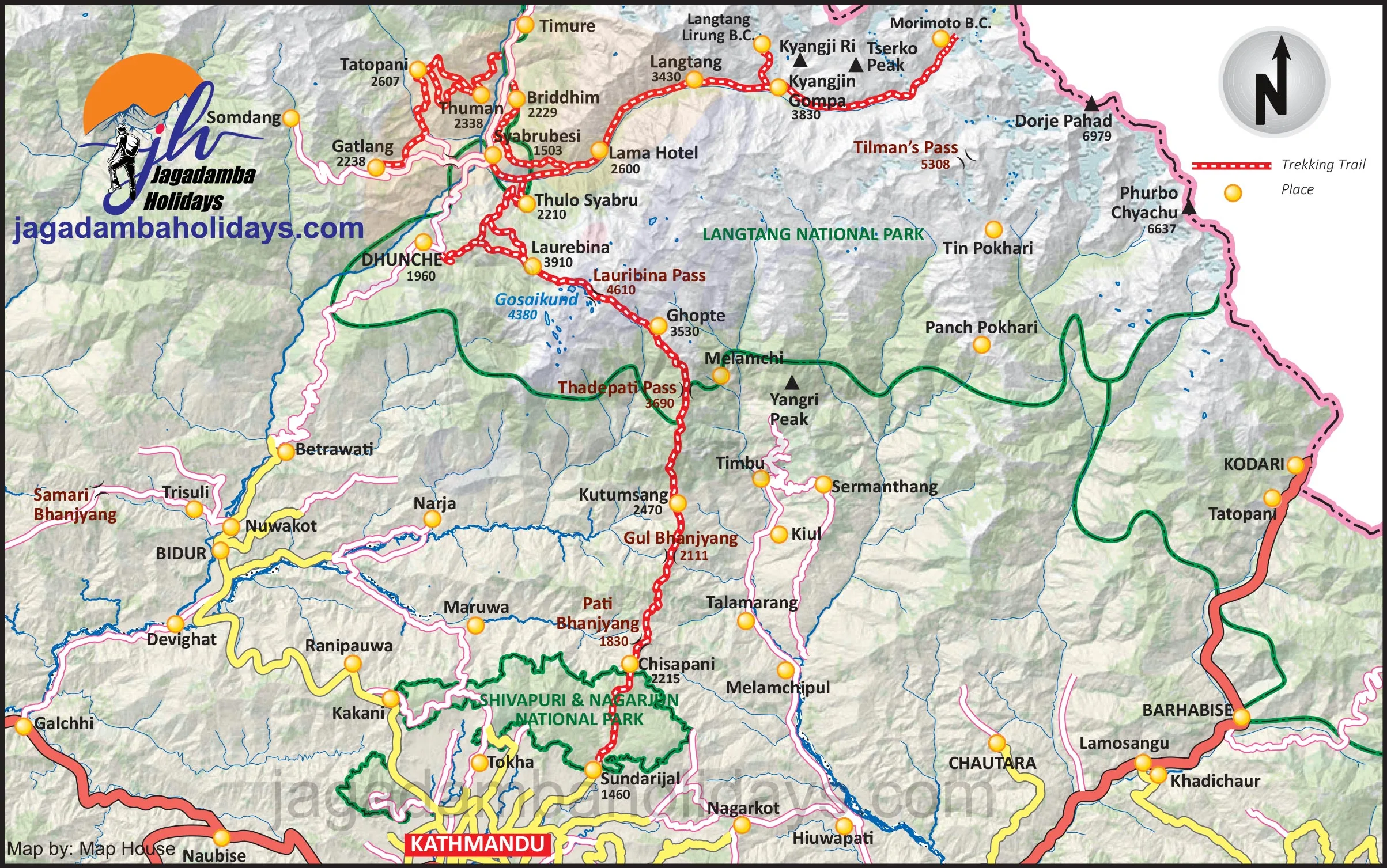
 Freqeuntly Asked Questions
Freqeuntly Asked Questions
 Reviews And Rating
Reviews And Rating
